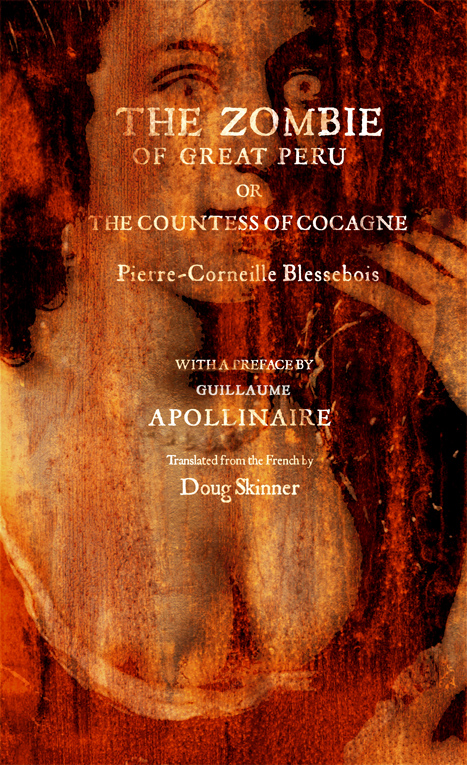The Zombie of Great Peru, or the Countess of Cocagne, by Pierre-Corneille Blessebois, rises from the grave in its first English edition, translated by Doug Skinner! It’s available now from Black Scat Books.
This bizarre novel, written in 1697, marks the first mention of the word “zombie” in world literature. It is a wicked tale of lascivious lust and lunatic desires, a strange concoction of prose and verse, from the sexual and racial hothouse of colonial Guadeloupe. Our narrator has his eye on the beautiful Creole Countess, who goes barefoot and serves her guests tadpoles. When she offers him sex in exchange for magical powers, he tricks her into thinking she’s an invisible zombie; slapstick, humiliation, and confusion follow. With a preface by the avant-garde magus Guillaume Apollinaire.
Pierre-Corneille Blessebois, also known as “the Casanova of the 17th century,” had an eye for the ladies and a taste for literary revenge. He was, at times, an arsonist, murderer, mercenary, deserter, and galley slave, finally ending up as a conscript in Guadeloupe. He wrote to boast about his sexual conquests and to mock his former partners; this book is no exception.


9 responses so far ↓
1 Win // Apr 4, 2015 at 11:44 pm
Who knew revenge porn had such a pedigree. Best in class, methinks.
Loaded question: do you think those tadpoles have anything to do with the English derogative for the French?
2 Doug // Apr 5, 2015 at 9:26 am
Curiously, the Zombie isn’t that explicit. Blessebois seems more preoccupied with justifying his deception, defending himself against charges of sorcery, and ridiculing the Countess for her gullibility. He also has the poor taste to boast about sleeping with her, and to mock her appearance. He was a piece of work.
Well, the English call the French frogs because the French eat frogs, so I guess it’s connected. Tadpoles are a popular dish in Thailand; I don’t know if they still eat them in Guadeloupe.
3 Win // Apr 5, 2015 at 9:17 pm
At the school I went to they would periodically serve a foul semolina dessert that we pupils referred to as tadpoles. It’s the only foodstuff of my youth that still has the Proustian ability to provoke a gagging response.
4 Roger // Apr 7, 2015 at 7:41 pm
Surely semolina was frogspawn, Win.
I don’t want to question your veracity, Doug, but I don’t hesitate to question Apollinaire’s. Like Frank Harris, he only told the truth when his imagination failed, and his imagination seldom failed with obscure lost books. Apollinaire found it less trouble to write them than to look for them. The fact that Pierre-Corneille Blessebois has made it to Wikipedia is not evidence for his actual earthly existence with Apollinairists/Apollinaireans around…
5 Doug // Apr 8, 2015 at 8:51 am
I know semolina with raisins was sometimes called tadpoles. I’m sure it differed from school to school.
You’re right not to trust Apollinaire, Roger, but in this case his sin was plagiarism rather than fraud. His introduction was almost entirely lifted from an 1862 edition. He was more interested in making a few francs with a quickie intro to an old dirty book than in writing one himself. The original 1697 Zombi du Grand-Pérou can be admired here: http://gallica.bnf.fr/ark:/12148/bpt6k1050610
Blessebois may seem too picaresque to be true, but he left a paper trail (he was always in trouble with the law); his biography was written by Frédéric Lachèvre. Pierre Louÿs took a special interest in the Zombie, and scoured colonial records to identify many of the people and places mentioned in the book. Blessebois was all too real!
6 Norman Conquest // Apr 8, 2015 at 11:14 am
Black Scat Books stands behind Apollinaire and Blessebois 1000%. We’re staking our reputation on THE ZOMBIE OF GREAT PERU!
7 Roger // Apr 9, 2015 at 2:47 am
You had raisins in the semolina at school, Doug?
Luxury!
Blessebois does seem to be real – and even less truthful than Apollinaire. I’ll look for him. Thank you.
8 Win // Apr 10, 2015 at 11:32 pm
You’re right, Roger, we did more often call it frogspawn. But there were high holy days when currants appeared in the gloop, as Doug notes, and then it was tadpoles.
Blessebois puts me in mind a little of Aphra Behn, Agent 160, whose biography is a blizzard of “may haves” and “might have beens,” and who was leveraging European ignorance of Caribbean climes to her advantage, in such tales as Oroonoko, a decade and more before the Frenchman. Did she ever really spend time in Surinam? I bet yes, but who can believe a spy?
9 Doug // Apr 11, 2015 at 6:34 pm
Behn and Blessebois are similarly adventurous and shadowy. Behn was more respectable though; she was spying for the authorities, whereas Blessebois was repeatedly imprisoned and exiled. She was a better writer, too. The world would be a better place without people like Blessebois, but he did write an entertainingly crazy little book.